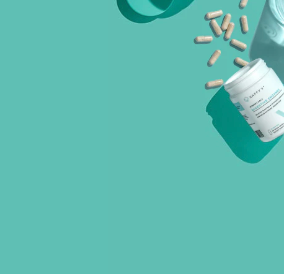- Fact Checked
- November 26, 2025
- 11 min read
Can Stress Cause UTIs? What Science Has to Say
Table of Contents
Table of Contents
Your body is amazing. It will almost always tell you when something's wrong… if you are able to stop and listen to what it's saying. And when your stress levels have gotten too high, your body has a kind of unusual way it might tell you: through your urinary system.
If you've experienced recurrent urinary tract infections, bladder urgency, or other urinary symptoms that seem to flare during particularly stressful periods, you're not imagining it. Research shows that women with high levels of psychological stress are 2.23 times more likely to experience recurrent UTIs than those reporting low stress levels. But the relationship between stress and urinary health goes deeper than infection risk alone. Let's dive into all the ways stress and urinary health are related and how to take action if you think your stress levels are leading to symptoms of a UTI.
This post is for informational purposes only and does not constitute medical advice. See full disclaimer below.
How Stress Disrupts Urinary Function
Chronic stress doesn't just affect your mental health. It actually launches a complex physiological response that affects multiple systems within your physical body, including your urinary tract and urethra.
It's actually not one way that stress can disrupt urinary function, but several, including:
Cortisol and Immune Suppression
Stress triggers cortisol release (which is rightfully often referred to as "the stress hormone). These elevated cortisol levels compromise immune function and weaken your immune system, making your body more susceptible to all kinds of infections, including UTIs.
New research suggests that chronic psychosocial stress and the elevated cortisol levels that come with them affects the balance protective Lactobacilli in your vagina. With fewer Lactobacilli, your natural immune defenses and immune response against infection-causing pathogens—like E. coli—go down. This is just one of many reasons why stress management matters for wellness and overall health.
Sympathetic Nervous System Activation
Stress activates your sympathetic nervous system, putting your body in "fight or flight" mode. This activation can disrupt normal bladder function, contributing to urgency, frequency, and incomplete bladder emptying. When your bladder doesn't empty completely, bacteria have more opportunity to multiply, leading to an increased risk of bladder infections and other bacterial infections.
Pelvic Floor Muscle Tension
Chronic stress often causes tension in your muscles, including in your pelvic floor muscles. This tension can interfere with normal urination patterns and contribute to lower urinary tract symptoms (LUTS) including urinary incontinence, pelvic pain, bladder pain, and bladder irritation. In some cases, these LUTS can overlap with overactive bladder symptoms.
Stress-Related Urinary Symptoms vs UTIs
Here's where things get a little tricky: while immune suppression due to stress can lead to actual UTI infections, other stress responses—like pelvic floor muscle tension—can lead to what are called "phantom UTIs," or sensations of a UTI that occur even when no bacteria are present.
Phantom UTIs cause common urinary tract symptoms like:
- Frequent urination or waking at night to pee
- Sudden urgency
- Burning or discomfort during urination (painful urination or a burning sensation)
- Pelvic pressure or bladder irritation
- Symptoms that intensify during stressful events or emotional spikes
But again, with phantom UTIs, you do NOT actually have an overgrowth of bad bacteria. So how can you tell the difference between a stress-related, phantom UTI and the real deal? There are a few key differences. Namely:
- Bacterial UTIs often include additional symptoms like cloudy urine or blood in urine, that phantom UTIs don't.
- UTI pain often ramps up quickly, while stress-related bladder symptoms may fluctuate throughout the day.
The best way to tell the difference, though, is to make an appointment with your gynecologist or other healthcare provider. They can take a urine culture that will identify if bacterial overgrowth is present (or not!).
Other UTI Risk Factors
Though some studies have found that as many as 60% of women with UTIs have reported high stress levels and various stressors, stress isn't the only risk factor for developing an urinary tract infection. Other common causes and risk factors include:
Sexual Activity
Having intercourse (sexual intercourse) more than once weekly increases UTI risk by 2.6 times compared to less frequent activity. Using diaphragms or spermicide for birth control and having new sexual partners are additional risk factors.
Hormonal Changes
Pregnancy, postpartum, and menopause are times of great hormone fluctuation, which puts your urinary tract at greater risk of infections.
Medical Conditions
Women with diabetes face 2.5 times higher likelihood of developing UTIs. Other conditions including kidney stones, interstitial cystitis, pelvic organ prolapse, and urinary tract abnormalities also increase risk. In men, an enlarged prostate can be a risk factor as well.
Catheter Use
Catheter-associated UTIs are the most common healthcare-associated infection, as catheters can introduce bacteria directly into the bladder and ureters.
Hygiene and Lifestyle Factors
Poor hygiene habits, inadequate hydration, consuming sugary drinks or cranberry juice (which isn't as effective as pure cranberry), wearing tight undergarments instead of cotton underwear, holding urine for extended periods, and using irritating feminine products all contribute to UTI development.
If you are one of the 35-53% of women who experience recurrent UTIs in any given year (meaning two infections in six months or three or more within a year), one or more of these risk factors may be at play. Understanding each of them ultimately helps you get to the root cause of your recurrence and end the cycle for good!
Stress Management for Urinary Health
If you feel like stress is contributing to your urinary tract symptoms (phantom or not!), there are evidence-based approaches you can implement to do to take the stress level down and help you find some relief:
Relaxation Techniques
Meditation and mindfulness training, breathwork exercises, and yoga all help regulate your stress response. These stress management techniques affect not only your mental state but also your immune system and gastrointestinal tract via the brain–gut microbiota axis.
When it comes to pelvic floor tension specifically, there are relaxation exercises that can help address these issues. A pelvic floor specialist can guide you through those in an appointment.
Physical Activity
Regular movement reduces stress hormones and supports immune function. And the good news is you don't need super intense workouts to feel the effects, either. Even a 15-minute daily walk or taking up an active hobby like pickleball provides short-term and long-term stress relief while promoting overall health.
Sleep
Quality sleep is non-negotiable for stress management and immune function. During sleep, your brain processes information and your body repairs itself, naturally reducing stress levels. Establish a consistent sleep routine, create a comfortable environment, limit screen exposure before bed, and practice relaxation techniques to improve sleep quality.
Cognitive Behavioral Therapy
For persistent stress or anxiety that affects your overall quality of life and not just your urinary health, cognitive behavioral therapy (CBT) offers effective tools for managing stress and its physical manifestations. There are many therapists who are specifically trained in CBT, and some are even covered by insurance!
A Support Network
Whether it includes friends, family, or a healthcare professional (or all 3!), a solid support system provides comfort and perspective during stressful periods. Women are noted to be more stressed than men, making support networks particularly valuable for women's urogenital health.
Treatment Options
Stress management techniques can work wonders for phantom UTIs and bacterial infections caused by a weakened immune system due to stress, but when it comes to treating actual bacterial infections, stress management alone is not enough.
To find relief from a true UTI, your doctor will typically prescribe:
Antibiotics
Antibiotics remain the most effective treatment for bacterial UTIs. Both three-day and seven-day courses show similar cure rates, so which one you use often comes down to your health history and personal preference. Remember that antibiotics require a healthcare professional's prescription. You should never take antibiotics that were not prescribed to you for this specific infection
Symptom Management
NSAIDs like ibuprofen reduce UTI-related pain by 50%. Warm compresses provide soothing relief for pelvic pain and bladder irritation. While these don't get to the root of the infection, they do help provide comfort while the antibiotics do their job.
Specialized Care
For chronic or recurrent symptoms, pelvic floor therapy addresses muscle tension contributing to urinary dysfunction and pelvic floor dysfunction. If there is any question of some sort of urinary tract abnormality, your gynecologist may also refer you to a urologist for specialized urology care, who can help identify any underlying conditions.
UTI Prevention Strategies
While antibiotics may be incredibly effective, the most effective treatment option for UTIs will always be prevention.
Once you have cleared any active infection, you can keep it from coming back through these proven habits to reduce UTI risk:
Maintain Hydration
Water helps flush bacteria from your urinary tract. Aim to drink three-quarters of your body weight in ounces every day. So a 120-pound person should target 90 ounces. If this is too hard to remember, 6-8 glasses of water tends to work for most people! Also avoid bladder irritants including sugary drinks, caffeine, and alcohol when experiencing symptoms.
Urinate Frequently
If you are drinking a lot of water, you will have to go to the bathroom pretty frequently. And this is a good thing. Each additional urination per day decreases UTI risk by 10% by flushing bacteria from your system, while holding urine creates conditions for bacterial growth.
Practice Good Hygiene
Though it seems simple, proper hygiene practices like wiping from front to back, urinating after sex, and avoiding douches and scented soaps or washes reduces UTI risk by up to 50%.
Keep a Urinary Diary
Especially if you have been struggling with recurrent UTIs, tracking symptoms, triggers, and patterns in a journal will ultimately help you and your healthcare provider craft the most effective treatment and prevention plan for you.
Use Preventative Supplements
Pure cranberry (not cranberry juice!) and D-Mannose have both been shown to prevent bacteria from adhering to the urinary tract walls, minimizing your risk of infection. Some women also use probiotics to support their vaginal microbiome.
Happy V's Cranberry & D-Mannose combines these two powerful ingredients into a convenient stick pack you can take anywhere. You can take them daily to keep recurrent UTIs at bay, or just take them as-needed, like after sexual activity or a hot day at the beach.
Recognizing When to Seek Help
While being proactive and taking control of your own urinary health is important, it's equally as important to know when to call for back-up (aka see your gynecologist).
Call your doctor if symptoms don't improve with hydration, rest, or stress-management techniques, or if you notice:
- Cloudy urine
- Blood your urine
- Fever or chills
- Lower back pain
These last two symptoms are especially important to look out for, as they can be a sign of a more severe urinary tract infection. And if you're dealing with repeated symptoms but your urine cultures keep coming back negative, ask for a deeper evaluation with a gynecologist or urologist.
Conditions like interstitial cystitis, pelvic floor dysfunction, or anxiety-related bladder symptoms often look like UTIs but need a different treatment plan. Getting clarity early prevents unnecessary antibiotics and helps you feel better, faster.
Final Thoughts
Stress and urinary health are absolutely connected. While stress can make you more vulnerable to real UTIs, it can also create "phantom" symptoms that feel identical, even when no infection is present. By managing stress, staying hydrated, practicing good hygiene, and using protective supplements, you can dramatically reduce your symptoms of real and phantom infections and also reduce your overall UTI risk. And if something feels off, trust yourself and talk to a provider. Your body's signals are always worth listening to.
Keep the Conversation Going
- Visit our blog for more women's health tips.
- Join our private Happy V Facebook group to hear from others who've been there.
- Explore supplements designed to support your vaginal health journey.
Disclaimer: This blog is for informational and educational purposes only and is not intended to diagnose, treat, cure, or prevent any disease. Statements about supplements have not been evaluated by the Food and Drug Administration. For more information about vaginal infections, visit the CDC or speak to a licensed healthcare provider.
FAQ
Does taking Happy V® D-Mannose + Cranberry help reduce the risk of UTIs?
Can D-Mannose be used alongside antibiotics for Urinary Tract Infection (UTI) treatment?
How much D-Mannose should be taken for a Urinary Tract Infection (UTI)?
Our experts continually monitor the health and wellness space, and we update our articles when new information becomes available.
- Published on: November 26, 2025
- Last updates: November 26, 2025
Written by Hans Graubard
Edited by Liz Breen












